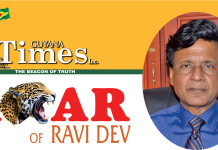In January 2005, with elections a year away, I proposed a “Centre Force” strategy for the plethora of smaller parties then around: ROAR, GAP, WPA — the three with single seats in Parliament — together with the JFAP, Unity Party and Vision Guyana, plus individuals who would soon form the AFC. We are at a similar juncture, and I again proffer the advice against the background that it was rejected then, but the “Third Force” that emerged died in stillbirth. This is being done for several reasons, but primarily because most believe they could work with “either” the PNC or PPP, but insist on not “together”. “ROAR entered the political realm to place on the national agenda two home truths: that our present politics are dominated by ethnic insecurities, and that we have to create a political system that would accommodate all the chosen representatives of the various groups in Guyana to deal with those insecurities. The first truth is now generally accepted by all and sundry, including most of the political representatives. The second is also generally accepted, so what’s the problem? The problem is one of credible representation of ethnic groups through the presence of their chosen representatives in the PPP and PNC. They believe they can address ethnic insecurities by co-option of ethnic individuals under “Civic” and “Big Tent” labels respectively. ROAR believes that the abovementioned proposals fall short. Smaller parties working with either one of the two dominant parties would inevitably leave the other out. It is unlikely that Guyana would have social peace if either of the two major parties is out of the picture. It is also improbable that any other party would be able to displace either of them at the next election. So how do we avert our tsunami of conflict? ROAR believes it is time for a “Centre Force” to be created and nurtured. What is this Centre Force? For one, it’s not a “Third Force” that feels it can wish away the PPP and PNC. It’s a Force that should seek to occupy the political, social, and cultural ground between the PPP and PNC, hence “Centre”. Today, in Guyana, there are a number of political parties outside the ambit of the PPP and the PNC — ROAR, GAP, WPA, JFAP, etc. — that can begin the process of creating this Centre Force. These could be joined by the parties now in formation by other committed Guyanese. What would be some incentives for these parties to work together? Firstly, the ineffectuality of the opposition (including the PNC) to influence the formation of policy should be an object lesson to those who believe “Westminster” politics can work in Guyana. Secondly, the experience of The United Force, both with the PNC (1964-1968) and PPP (2001-present) demonstrates the inadvisability of the smaller parties seeking a coalition arrangement with either the PPP or the PNC. There’s the matter of “the disequilibrium of size” when it comes to coalition between parties of vastly different strengths, it matters not the good intentions of the parties seeking to coalesce. If a mosquito joins forces with an elephant, it should not be surprised when it is taken for granted, or even ignored during crucial decisions. There’s the iron law of oligarchy: In all organisations, power will accrete in the hands of a few, and we can be sure the few won’t come from the ranks of the mosquitoes. What would be the ground rules for a Centre Force? Firstly, they should not get together simply to deny the PPP or the PNC the government. That would result in a “coalition of convenience”, which would quickly and acrimoniously fall asunder. They would have to be committed to a common programme to form a “coalition of commitment”. This does not mean that they have to agree on each and every point. That they are different parties means that they do not agree on each and every point. There’s nothing wrong with that; and in fact there’s everything right with it. The way forward is a confederation of parties, wherein they keep their identities as they work together to craft a common and truly national programme (because of their diversity) for Guyana. In the crafting of such a programme, it is possible (and in our estimation quite likely) that much common ground can be found. And it would also demonstrate to the Guyanese people that there are compromises each of the small parties are willing to make to work together for Guyana, and not just preaching it to the PPP and PNC individually.










